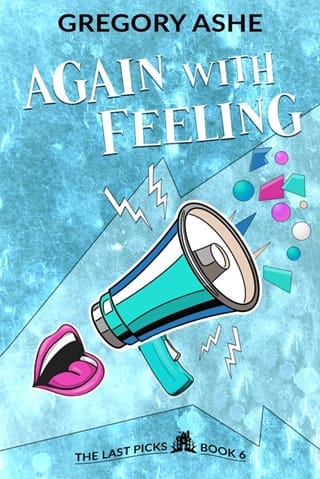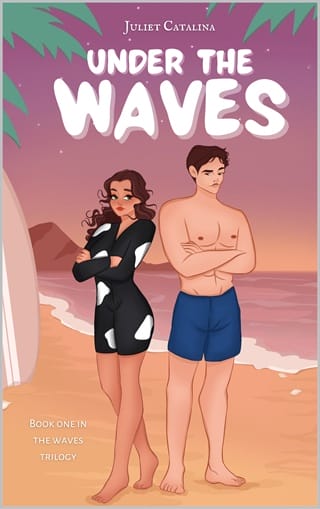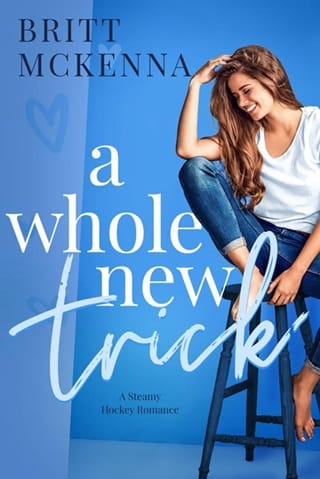Chapter 15
I sprinted through the dark house, clutching Bobby’s keys. If he chased me, I didn’t hear him—I couldn’t hear anything over the hammer of my steps and my ragged breaths. A moment later, I was bursting out into the pleasant cool of an evening on the Oregon coast, the air sweet with hemlock and timothy and cedar and the brine of the sea. I climbed into the Pilot and started the car, and I sped down the drive. Then I was driving north, into the fog belt and the forest of spruce and fir and fern, where the trees rippled and whispered like a darker ocean.
I didn’t have a plan. I wasn’t even thinking, really. I’d gone into flight mode, and the higher-level functioning of my brain had completely shut down. But as the cocktail of hormones ebbed, clarity started to return. I couldn’t go far. I was technically committing grand theft auto, for one reason. And, for another, where would I go? Back to my parents? Was I legally required to move after—well, whatever you called that scene back at Hemlock House? A farce? A travesty? A debacle?
A fight. A horribly, ugly fight with my best friend.
I want you to be happy .
I knew if I let myself think too much about what Bobby had said—what we had both said—I’d fall apart again, so I forced myself to take deep breaths, to let my thoughts slide away. They were leaves on a river, carried away by the water. They were cars on a road, zipping past me. They were, uh, pages in a book? I kept falling asleep during the meditation app, but there was probably another good metaphor in there somewhere.
By the time I pulled into the Hastings Rock Public Library’s parking lot, I could have passed for a human being (if you didn’t look too closely). I sat there for a while, my hands shaking until I clasped them in my lap. I let my head fall back. I closed my eyes. As the adrenaline leached out of my body, exhaustion took its place, accompanied by a renewed awareness of every ache and pang from the prior day’s accident. I couldn’t fall asleep. I had to work up the courage to drive back to Hemlock House. I’d leave the keys under the doormat, the way they did in movies sometimes. And I’d write a quitclaim deed leaving the house to Indira. And then I’d wander off into the forest and get eaten by a bear. Like that guy in that movie who got eaten by a bear.
Or, God help me, I could try— try —apologizing to Bobby.
But what would I say? Yes, I’m in love with you. You make me happy every day. I want to spend every minute I can with you. You’re smart, and you’re funny (but not too funny, like, in an annoying way), and you’re so good with Keme that sometimes I think you have a built-in dad mode that got activated when you were twelve. You move your head when you listen to music, sometimes. You keep time with your fingers on your chest. You have this way of being in a place, in a space, like you have your own gravity, and even though every other hour of the day I feel like the ground is crumbling beneath me, when I’m around you, it’s like I’m standing on something solid, and everything makes sense. So, yes, I want to spend the rest of my life listening to you explain why I can’t park there because it’s a red curb—
Someone tapped on the window.
I screamed.
Someone else screamed.
Somehow, I managed to crawl back inside my own skin and turn to look out of the Pilot.
Mrs. Shufflebottom stood there. Hastings Rock’s head librarian had white hair, piercing eyes, and cardigans so disturbingly tight that they looked like straitjackets. (Like, you have no idea. It looked like she was vacuum sealed inside those things.) She was a heck of a librarian, from what I could tell—I was a regular patron, and the library had an impressive collection—and she did a fantastic Mrs. Claus at Christmas. She was also my self-proclaimed nemesis, and right then, she was staring at me through the window like she wanted to brain me, clutching her cardigan at her throat.
“Oh my God,” I said. “I’m so—” I buzzed down the window. “I’m so sorry. You startled me.”
To my surprise, Mrs. Shufflebottom gave a little laugh, and her chokehold on the cardigan relaxed. “And you startled me , Dashiell.” I opened my mouth to correct her, but there was something strangely pleasant about how she said my full name. “You’re parked in front of—” But then she stopped. “Are you all right?”
“Yeah, thanks.”
It wasn’t super convincing, though, because I started to cry. Not sobs. Not even tears running down my face. But my eyes stung, and I dropped my head.
Mrs. Shufflebottom made a soft noise. She patted my shoulder and said, “It’s okay. It’s okay. It’s all going to be okay.” I wasn’t sure how—witchcraft, maybe—but somehow she got the Pilot’s door open, and the next thing I knew, she was urging me out of the car. “Come inside and have some tea.”
About my only coherent thought was to hope that, since she was my nemesis and all, it would be poisoned tea. Maybe she’d bury me under the library. Maybe I could be a not-so-friendly ghost haunting the cookbook section.
The library wasn’t much to look at. It was a single-story brown building with a utilitarian design at odds with the rest of Hastings Rock’s picturesque charm. Inside, it smelled like well-used carpet, aging paper, and the damp that settles into cloth and wood but that isn’t quite mildew. The fluorescents were bright, but the acoustic tiles were water stained, and the windows were small and made the library feel unexpectedly close.
Still, Mrs. Shufflebottom had done her best. As I said, it had a first-rate collection, and although the furniture was mismatched, it was clear that she’d purchased items in an attempt to maximize comfort and usability (and frankly, cleanability—you’d be surprised at the kind of stuff people get up to in a library). (Not that. Get your mind out of the gutter.) She settled me in a plush armchair near the circulation desk and left me. I could hear her bustling around in the staff-only area. Before long, she came back with a tea service. This was the second time in the last week someone had brought me a tea service. I wasn’t much of a tea drinker, but it made me feel so civilized.
After pouring the tea and offering me milk and sugar, Mrs. Shufflebottom seemed content to sit in silence as we drank. The mug was pleasantly warm between my hands, and although I wasn’t a tea connoisseur, it tasted good. Some of the knots in my body untied themselves. Another wave of emotion washed over me, but it was gentler this time. Disappointment. Loss. Grief. I dabbed at my eyes with one of the little paper napkins and breathed my way through it.
Mrs. Shufflebottom patted my knee. “Do you want to talk about it?”
I shook my head.
“Shall I call someone for you?”
“No,” I managed to croak. “Thank you.” And then—because even in the depths of despair I was still, unmistakably, Dashiell Dawson Dane—I blurted, “Why are you being so nice to me?”
She patted my knee again, but she didn’t answer for what felt like a long time. “I believe we got off to a bad start, Dashiell. I’m not happy about that. When you arrived, the circumstances with Vivienne, and then, of course, that scene with Pippi—” She took a breath and set her mug down. It clinked against the tray. She clasped her hands. “I believe I am a fair person, and I’d have to be blind not to see the good that you’ve done for people in this town.” She held up a hand when I opened my mouth. “I don’t only mean the murders, young man. You’ve been a good friend to people whom this community has not always treated well. You’re kind and respectful. You’re a library card holder, and that goes a long way with me.” It took me a moment to realize she was making a joke, and a crooked grin slipped out of me. She offered a small smile back. “And I was also very impressed that you didn’t object or explain about the books. You simply paid the fine and went on with your day, even though someone else might have taken the time to explain that Keme had been the one who made you spill the hot chocolate.”
I wasn’t sure that anybody got so worked up about library fines that they had to blame a teenager, but then I said, “Wait—”
“Millie told me,” Mrs. Shufflebottom said with another of those small smiles. “Your friends think very highly of you.” After a quiet moment, she said, “I would like to apologize. I hope that I can be a better librarian to you in the future.”
“You don’t need to apologize. I mean, thank you. This is all—you’re being very kind.” My emotions were unraveling again. I grabbed some more of the napkins, wadded them against my face, and waved blindly at the tray. “You didn’t have to do this.”
“But I wanted to,” Mrs. Shufflebottom said. And then, in a tone I could only call strained, she said, “And I certainly couldn’t stay angry with a young man who was willing to help Vivienne Carver. I know what she did, and I know what it means, but—but she was important to me, and to this town, for a long time. She was my friend. Is my friend, I suppose. And when you’re my age, I don’t know how to explain it—I certainly don’t condone her behavior, but perhaps, in a way, I understand it.” She rose, waving for me to stay in my seat. “I’m trying to say I’m thankful. I know you didn’t have to help her. I’d like to show you something, if you have a minute.”
I nodded. I had plenty of minutes—as long as it took for the sheriff to show up and arrest me for taking Bobby’s car, as a matter of fact. Plus, the tea really was good, and the chair was super comfortable, and I was so toasty warm, inside and out, that I was wondering if Mrs. Shufflebottom had a spare throw or a blanket. There’s nothing better for emotional turmoil than a good six-to-eight-hour nap.
When Mrs. Shufflebottom came back, though, she was holding a book. It was a hardcover still in its dust jacket. The dust jacket was old and faded and, in spite of Mrs. Shufflebottom’s best efforts, showing the faintest hints of wear. Unlike the books in the library’s collection, though, this one didn’t have a barcode or a spine label or the protective cover to keep the dust jacket from getting torn to ribbons. It took me a moment to realize that this book must have come from Mrs. Shufflebottom’s private collection—or maybe from an archive, if the public library had such a thing.
Then I saw the title.
Death at Maplewood Manor had been Vivienne Carver’s first novel—published before she helped solve the Nightingale murders and became an overnight celebrity. Of course, now I knew the truth: Vivienne hadn’t helped solve the murders. Death at Maplewood Manor had been something of a flop, and Vivienne had needed a way back into the Forbidden City of publishing. So, she’d done what anybody would do. She’d fabricated a serial killer and framed an innocent woman, and in the process, she’d laid the foundation for a career as the self-proclaimed Matron of Murder.
It was hard to separate the truth from the memories that surged up. Death at Maplewood Manor had been the first Vivienne Carver book I’d read, and I’d read this same edition— part of my parents’ personal library of mystery novels. The same dust jacket. The same murky art that made me grateful book cover designers had found a new direction after the 1980s. Even the smell of the yellowing paper and old glue brought me back to the first time I’d opened one of Vivienne’s books. And I’d fallen in love, like most of the world, with the work of one of the best writers of our time.
When I opened the cover, I was surprised to recognize Vivienne’s familiar handwriting. The inscription read, To Agatha (that’s my favorite name!), very truly yours, Vivienne Carver .
“I wanted to show you because I know what she’s done,” Mrs. Shufflebottom said, “but she was a kind person, once.”
I nodded, and I thought of the photo Jane had shown me of four teenagers with their whole lives ahead of them: the bright smiles, the hopeful eyes, the sense of the bond between them so palpable that it could only be called love. “I’m sure she was.”
We were both silent then. From the children’s section came a little boy’s laughter and the murmur of a woman’s voice. A middle-aged man in a baggy, collarless shirt lugged a stack of books toward the circulation desk.
Mrs. Shufflebottom cleared her throat and tapped the cover of Death at Maplewood Manor . In the voice of someone trying to act casual after a moment of strong emotion, she said, “It hasn’t aged as well as her others, of course, but it’s still a treasure.” I caught a hint of a smile as she added, “Please don’t let Keme startle you.”
Did Mrs. Shufflebottom just make another joke? I wasn’t prepared to consider that possibility.
I drank the rest of my tea (careful to keep it away from the book, of course), and tried to understand what Mrs. Shufflebottom had meant. Death at Maplewood Manor hadn’t been an initial commercial success, but after Vivienne’s star began to rise, critics—and readers—found a great deal to love in the book. I scanned the back copy, and it started to come together for me. Mrs. Shufflebottom was right; Death at Maplewood Manor had not aged as well as some of Vivienne’s other work, mostly because the book was built around a shocking revelation that, in 2018, was significantly less shocking.
The twist had to do with the victim’s affair. Throughout the book, it was clear that figuring out the identity of the victim’s romantic partner—the last person to see her alive at a midnight tryst—was the key to the whole mystery. And Vivienne did manage to shock people—in 1987. Because in Death at Maplewood Manor , the twist was that the victim’s lover was a woman!!!!!!! (Shock. Awe. Gasps.) (God, using that many exclamation marks felt unbelievably liberating.) So, in that sense, Mrs. Shufflebottom was right—the novel felt dated. Homosexual relationships didn’t (or shouldn’t) have shock value anymore, and trying to use them that way went against decades of work to normalize them.
On the other hand, like most of Vivienne’s work, it was a master class in the craft of mystery. One of the reasons the twist worked so well in Death at Maplewood Manor is that Vivienne never does anything so crass as have a character say, “Well, she was a red-blooded American woman, so we’re looking for a man.” Instead, she let the reader’s assumptions do the work for her; most readers, like the other characters in the book, simply assume that the victim’s lover would be a man. It was an excellent example of an old saw among mystery writers: readers will mislead themselves . All you have to do is show them what’s happening, and they’ll make up their own story—and, bonus, it’ll be much more convincing than any red herrings or misdirection you could fabricate on your own.
All the great mystery authors do it to greater or lesser extents. Elizabeth George does it in her Inspector Lynley novels—while investigating a suspect’s home, Lynley finds a shrine to his wife. The implication—and the reader’s assumption—is that the woman is dead, and the shrine is a display of grief. But it turns out (spoiler alert!) she’s alive!!!!!!! (I’m serious, it feels amazing. You should try it sometime.) Daphne du Maurier does it—that’s basically (spoiler alert) the entire plot of Rebecca!!!!!!! (Okay, that one felt like too much.) Agatha Christie was so good she could do it over and over again, and somehow she always made it work. And, of course, Vivienne had done it here, as well as in many other novels.
Holding Death at Maplewood Manor in my hands, I couldn’t help but wonder how much of the plot, with that final revelation of an illicit lesbian relationship, had been born out of Vivienne’s life. It’s a fallacy, and a dangerous one, to conflate an author with their characters, but it was Vivienne’s first book, and she’d written it so close to the events that had devastated her emotionally—the death of her brother, the loss of her lover, the decision to leave behind everything and stake her future on the belief that she was capable of greatness. Was it really so much of a stretch to think that the immediacy and power of that time in her life must have shaped the story she was telling?
It would be nice if it did, I thought with wry weariness. It would be lovely if I could flip through the book, spot an easy analogue for Richard’s death, and identify the killer all these years later. As though it were a secret Vivienne had buried in the text for someone else to find. Of course, that was nonsense—if she’d known who had killed Richard, she never would have hired me in the first place. Still, it was a fun idea. I tried to think of a mystery novel that featured a sleuth who solved a crime in the past by unraveling the plot of a novel. The Josephine Tey book came closest. It wouldn’t even be all that difficult to work in that trick about having the reader mislead themselves. I mean, it happened in real life all the time—look at me. I’d assumed Vivienne and Jane had been straight simply because they’d married men—
The revelation had a physical weight, dropping in my gut. Richard’s distance from his father. Richard’s arguments with everyone in his final months. Neil and Jane. Neil wearing Richard’s bracelet.
I was an idiot, I decided.
I laid Mrs. Shufflebottom’s book on the counter, shouted, “Thanks for the tea!” and sprinted for the door.
Mrs. Shufflebottom’s polite—but stern—“Inside voice, Dashiell,” floated after me into the night.
 Fullepub
Fullepub 



